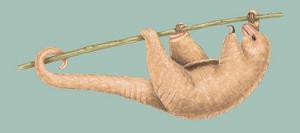The silky anteater (Cyclopes didactylus) is the smallest member of the mammal family of anteaters. With its size and color, it is an appealing little animal, living in a range from Mexico to Bolivia and Brazil.
What is the appearance of a silky anteater?
The silky anteater is covered with a silky fur that is yelllowish-brown, almost golden in color. The silky anteater reaches a body length of about six to seven inches, with a prehensile (definition) tail slightly longer. Typically, the silky anteater does not weigh over a pound.
Unlike other anteater species, the silk anteater has a thick, short snout, almost pig-like. Typical of its family, it has no teeth. The name didactylus means two-fingered or two-toed, referred to its front limbs, with hand-like structures that have two stunted digits and two long digits with large claws. The claws on the hind feet are shorter.
What is the life of a silky anteater like?
The silky anteater is arboreal; that is, the silky anteater lives in trees, with a preference for kapok trees, which have fruits the same color as their fur, thus providing camouflage and protection for predators, mainly birds. Under attack, the silky anteater stand up on its hind legs (like other anteaters), using its claws and prehensile tail to support itself; it defends itself with its front claws, as it raises its hands up to its face, almost like a boxer. With its prehensile tail, the silky anteater is a superb climber, although it moves through the tree limbs slowly and carefully.
Since the silky anteater is nocturnal, active at night, it has poor vision and relies on the senses of smell and hearing to locate insects. During the day, it sleeps, sometimes together with other silky anteaters, but not much is known about the social life of the species. It is very shy, rarely seen even by scientists, but it is not considered endangered.
What does the silky anteater eat?
It should be no surprise that an anteater eats ants. The silky anteater also eats termites and other insects. It is well-equipped for this very specialized diet, with strong limbs and claws to open ant nests and with a long, sticky tongue. Since ants are so small and have so little nutritional value, even the silky anteater, so much smaller than other members of its family, has to eat thousands of ants a day.
How does the silky anteater reproduce?
After a pregnancy of about four to five months, the female silky anteater gives birth to a single baby, in a hole in a tree. Both parents take part in tending to the infant. The baby nurses at first and later feeds on insects which the parents regurgitate to feed it. Scientists have not determined how old the infant is before it goes out on its own.
Do you want to learn more about the silky anteater?
I consulted Grzimek’s Animal Life Encyclopedia, volume 13, for this article. You can, of course, find information about silky anteaters at Wikipedia (here). You can find an index page to my articles on animals here.
